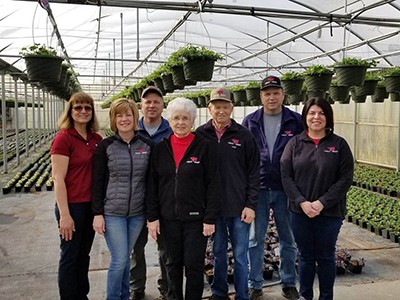Fessler Nursery switches from white light to “pink” LEDs and sees faster turns, stronger plants
Celebrating 60 years in the business this year, this Oregon greenhouse and nursery operation is finding continued success with supplemental Philips horticulture LEDs.
Putting out a horticultural technology that proves a hit with growers is perhaps not as complicated as it would sometimes seem.
“When you find a product that improves your plant quality and also reduces expenses, you stick with it,” says Fessler Nursery’s Debbie Farrell.
Farrell, who serves as the Woodburn, Oregon, operation’s propagation manager, is referring to the Philips LED toplighting arranged throughout Fessler’s 800,000 square feet of greenhouse production space. The group started out with supplemental LEDs back in 2017, purchasing a fleet of unnamed white LED lights that left the group wanting something a little more optimized for rooted nursery stock.
“While we saw great improvement in rooting, we weren’t as impressed with the final quality of some items,” she remembers. “In 2018, John Crisp (the Ball Horticultural sales rep for Oregon) sold us our first Philips [brand] LED lights. We filled one bay with the pink [Philips] LED lights. In 2019 we added two more bays, and in 2020 we have added another bay. Our goal is to continue to replace the HPS lights with the Philips pink LED lights.”
Improved crop quality, stronger roots
Farrell says that since making the switch from HPS to the Philips LEDs for the nurseries’ supplemental lighting, the groups growers “haven’t found a plant that doesn’t like the pink LED lights.”
“Everything that we have rooted in them has performed better than under the high-pressure sodium lights, or even those white LEDs that we started with,” she adds. “The Philips lights have allowed us to use little to no PGRs on the items grown under these lights, and we can reduce our growing times by 1-2 weeks and the plant quality is better.”
An added benefit to faster vegetative growth in the greenhouse is the ability for Fessler’s growers to stage available production space more efficiently, allowing for more production turns per season, according to Farrell.
An Organizational Fit

Having wrapped up its 60th growing season in operation this year, to call Fessler’s a family business would perhaps be underselling the point. Pretty much Ken and Marie’s entire brood, plus their spouses, are all involved in the production of the nurseries’ many plant offerings.
“Katy (son Marvin’s wife) runs the retail outlet in the spring, and my brother Marvin is charge of the finished spring annuals,” Farrell, Ken and Marie’s only daughter, explains. “My father Ken still shows up at the nursery every day and does whatever he feels needs to be done from weeding to trimming. Dale (son) is in charge of the foliage program, and his wife Janie works in the main office doing order entry, customer service, personnel, etc.”
The founding Fesslers, Ken in particular, reportedly have always taken a keen interest in the newest and best horticultural technologies, according to Farrell.
“They think it’s great,” she says, referring to her parent’s thoughts on the Philips LED toplighting. “Anything that will make the plants root faster saves labor for us, and Ken has always been looking for ways to improve efficiency and save on labor.”
For her part managing the operation’s Selecta One root-and-sell breeding program, Farrell wholeheartedly agrees with her parent’s assessment of the lights. That’s because the Philips lights have checked the ultimate box when it comes to new technologies and why we invest in them: they make her life better.
“My job has become less stressful since adding the Philips pink lights,” she says. “I don’t worry as much about the plants grown under the Philips lights, and the uniformity and quality are so much better.”
